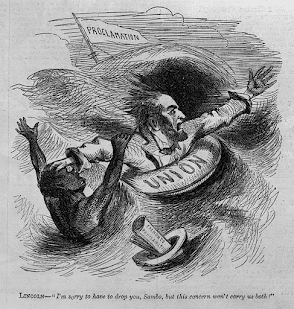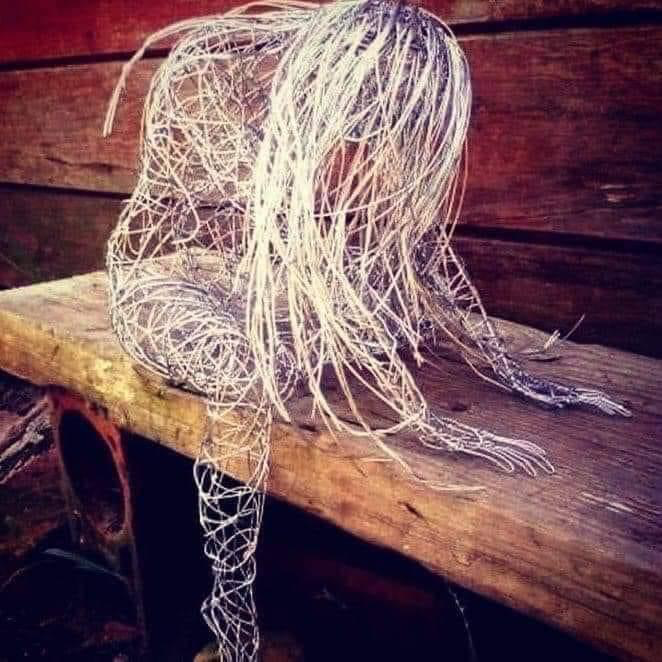Sambo and Uncle Tom
Caption: "I'm sorry to have to drop you, Sambo, but this concern won't carry us both."
Source: Library of Congress
On August 30, 1861, without President Lincoln's
approval, General John C. Freemont took it upon himself to issue a proclamation
emancipating the slaves owned by Missouri Confederate sympathizers. Not wanting
to anger bordering states, Lincoln was more concerned with saving the
"Union" than freeing the slaves. Hence the cartoon depicts papers
floating in the water labeled "Freemont proclamation" and the ship
flying a pennant with the simple words "Proclamation" in the
background. The Sambo pejorative referring
to all the enslaved is more than a coincidence. Sambo was, in many ways, the
embodiment of the "perfect" slave, at least in the minds of the
Confederacy. So, who was this "Sambo"?
One of the earliest Sambo caricatures appears in the
1808 short story "Sambo and Toney: A Dialogue in Three Parts " by
Edmund Botsford. Sambo seems highly intelligent, thoughtful, and Christian in
their earliest portrayals. Consider these passages:
Therefore, we see two representations of the slave:
Christian Sambo and non-Christian Toney. According to this portrayal, neither
Sambo nor Toney is stupid nor dense. Botsford, a Baptist minister, could have been better. However, he believed that Christianity would help ease some of the harsher
aspects of slavery for both the enslaved person and the enslaver. He observed
that "slavery in its best state is a great evil" and that only
through Christianity could the enslaved person become cooperative and accepting
and the enslavers become less violent and more tolerant. (Ford
2011;161).
Sambo appears in print in Harriet Beecher Stowe's book - Uncle Tom's Cabin. In this book, Sambo, a slave overseer working for the cruel enslaver- Simon Legere, is juxtaposed against Uncle Tom, a pious, god-fearing, compassionate man. In a strange twist, Uncle Tom refuses to reveal the whereabouts of two slave women hiding. These women had been sexually abused by their masters. Knowing that he would be beaten to death for refusing, Uncle Tom held fast. For this, he was tormented and beaten to death by Sambo. And in his dying breath, Uncle Tom forgives Sambo.
While Stowe aimed to produce an anti-slavery book, it
still presents these two diametrically opposed Black male characters -one noble,
Christian hero, the other docile, violent, and dedicated to his master. In a
strange twist, Uncle Tom has become villainized as an ultimate Black "sellout."
But in Stowe's book, Tom is a heroic and courageous Black man who used his
charm and insider position as a House servant to gain access to writing
materials, food, and information by which and through which he aided other
enslaved Black people not only to survive but to escape slavery. Conversely,
Sambo has been rendered the impotent, docile, ignorant, and servile linguistically
challenged buffoon. The next section will see how these two characters have
continued through history.
Uncle Tom
Harriet Beecher Stowe wrote Uncle Tom's Cabin to combat
the 1850 passage of the Fugitive Slave Act, requiring northerners to return
runaway slaves to slavery and the South. Pouring through slave narratives of slaves
escaping along the Underground Railroad, she came across the account of Josiah
Henson (1848). Henson became the ideal by which Uncle Tom took literary life, and along with
other texts, she assembled the other characters to compile Uncle Tom's Cabin. The
book, over time, outsold the Bible; it has become one of the most successful
books of the period, and by the late 1950s, it was being dramatically portrayed
in minstrel shows and theaters throughout the United States and England. The
story so inflamed radical conservatives that alternative and revised perspectives
were offered. Southern white planters were redeemed, and Black people again
were submerged into inferiority in the novels that appeared. One such book, The
Clansman, the source of the first feature-length film -The Birth of a Nation,
was written as a counter to the literary accomplishments of Uncle Tom's Cabin. (Turner cited in Martin
2008)
Over the decades, Uncle Tom has been stripped of his
humanity and transformed into the docile, castrated, happy-to-please-whites at
any cost stereotype. Uncle Tom is repackaged and appears as Bill "Bojangles"
Robinson in the Shirly Temple films of 1930. In these movies, the singing and dancing
companion becomes the tender companion of his child patron, Little Eva. Another
repackaging, this time taken from the Uncle Remus tales of Joel Chandler Harris
in the 1880s. In 1946, Uncle Remus was adapted by Disney in its film "Song
of the South."
Uncle Tom became a reality as Black men and women were
forced to live under Jim Crow. To violate the laws, norms, and rules of Jim Crow
would mean risking their homes, jobs, and even lives. One of the main jobs that
Black men could work during this time was that of the Pullman sleeping car
porters. For many whites, this perfectly represented the humble Uncle Tom. But,
as we will see in the last section, the Black Pullman became the frontline troops
for the modern Civil rights movement.
Uncle Tom became a fixture in many homes as Mars Food
launched its new Uncle Ben's Rice in 1947. Over the past seven decades, it has
been the best-selling rice in the U.S. The company even invented the myth that
the rice originated from a Black Texas farmer "known for his high-quality rice."
The actual character was the head waiter at a Chicago restaurant, Frank Brown,
whose face had been on the packages since its inception. To redeem what for
years had been seen as a humble, racist character, the company tried to elevate
Ben to the chairman of the Board in 2007. (Elliot
2007) Then in the aftermath of the George Floyd murder, Mars joined other
companies to remove the racist images of Uncle Ben. (Booker
2020)
Django Unchanged (2012) again repackages Uncle Tom in
the staunchly loyal and suspicious head house slave Stephen Warren. Stephen, devoted
to death and contrary to the original Uncle Tom, betrays the trust of the enslaved
person's rebellion led by Django. He dies as Django watches from a distance as an
explosion destroys the slave mansion. And so we have come full circle from the
original Uncle Tom's cabin.
A series of Black men (both in film and the real
world) has been accused of being a sellout Uncle Tom. This includes roles
played by Paul Robeson (Emperor
Jones), Sidney
Poitier, and Bill
Cosby shows during the 70's and 80s. (Abrams
2021). The list includes Morgan Freeman playing Hoke in Driving Miss Daisey
(Zanuck, Zanuck & Beresford,
1989). And in real life, several black men have been labeled, including O.J.
Simpson, Detroit Mayor Dennis Archer, Karl Malone (Utah Jazz basketball Player,
Colin Power, and of course, Clarence Thomas. ( Ferris 2000)
Sambo
It was through
the popularity of the minstrel shows of the 1830s that Sambo became a common
theme among white, working-class audiences. Sambo, sometimes Tambo, or Zambo,
or Jim Crow represented that happy slave who was loud, cheerful, and without a
care. Even as slavery ended and separate but equal became the law of the land,
Sambo, always knowing his place," provided comfort as he enjoyed his
ignorance, danced through his travail, and never had to worry about a thing. Then,
as America discovered radio and television, Sambo and Toney became Amos and
Andy. And much like the earlier minstrel shows, two white men performed in
blackface and preserved America's lovable Sambo.
In the early days of motion pictures, Lincoln Theodore
Monroe Andrew Perry (1902-1985) took Sambo to a new level with the character "Stepin
Fetchit. Fetchit, billed as the "Laziest Man in the World" who was touted
as being slow-witted, shuffling, and head-scratching," became one of the
highest-paid actors in Hollywood. He was also the first Black actor to earn $1
million and the first to be featured in a film.
(Lamparski
1982 and Clark,
2005)
Source: Stepin Fetchit – Stepin Fetchit In Person (1961, Vinyl) -
Discogs
Sambo succumbed to the civil rights movement as major Black
comedians and activists such as Godfrey Cambridge and Dick Gregory refused to
play the role. (Boskin
1986)







Comments
Post a Comment